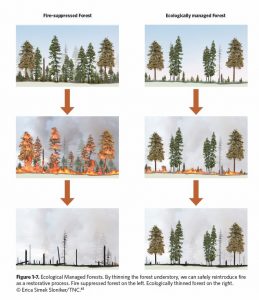An item from the American Forest Resource Council‘s July newsletter. This edition has another entry on the topic, about hazard tree litigation in California.
Hazard Tree Removal Litigated
Last month the California-based Klamath Forest Alliance filed a complaint against the Rogue River-Siskiyou National Forest on a project that aims to remove fire-killed trees posing a danger to roads following the 2020 Slater Fire.
The Slater Fire Safe-Reentry Project proposes to remove hazard trees affecting 146 miles of travel corridors, including the mainline road connecting Cave Junction and Happy Camp. The Forest authorized the proposed actions using a Categorical Exclusion that allows various road maintenance activities. Among other things, the plaintiffs argue that the Forest Service violated the National Environmental Policy Act (NEPA) by failing to prepare an Environmental Assessment (EA) or Environmental Impact Statement (EIS).
The Rogue River-Siskiyou opted to defer consideration of any timber salvage on the Slater Fire and instead focus its planning resources on the Safe-Reentry Project. This decision has become the status quo for most National Forests impacted by severe wildfires as timber salvage, a silvicultural tool, has been deemed too risky due to threat of litigation and the associated delays that render fire-damaged timber useless to local manufacturers. To date, the four western Oregon National Forests, the Mt. Hood, Willamette, Umpqua, and Rogue River-Siskiyou, have only proposed area salvage on 750 acres of the 377,000 acres impacted by last year’s wildfires—that’s less than 0.2% of the burnt acres.
It remains to be seen if special interest groups will also challenge that 0.2%, but it’s clear that resources are being deployed to halt the removal of any fire-damaged trees posing hazards to Forest Service roads. Currently, the mere threat of litigation has resulted in the continued closure of hundreds of miles of Forest Service roads to public access. The Rogue River-Siskiyou has 146 miles of roads closed due to hazard trees related to the Slater Fire, the Mt. Hood has 257 miles of roads closed due to hazard trees related to the Riverside and Lionshead Fires, and the Willamette has 407 miles of roads closed due to hazard trees related to the Holiday Farm, Beachie, and Lionshead Fires.
In total, over 800 miles of Forest Service roads in western Oregon remain closed to public entry due to delays in removing hazard trees created by wildfire. By all reasonable accounts, the Forest Service has three options to address these hazards:
- Close these 800+ miles of road indefinitely
- Sell the hazard trees to timber purchasers for manufacturing into wood products
- Use tax dollars to pay for the hazard trees to be felled and left on site
Given the state of the Slater fire litigation, and the threat of similar lawsuits on the other Forests, option three may be the only path forward. How much money this would cost is uncertain, but the Archie Creek Salvage EA prepared by the Roseburg BLM District estimated that it would cost up to $4 million to fell and leave hazard trees along roads associated with the Archie Creek Fire. This price tag applied across the vast Forest Service road network would be significantly higher. /Andy Geissler

